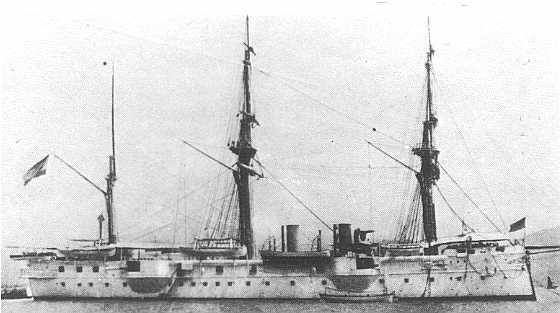


The cruiser CASTILLA was built in Naval Shipyards of La Carraca (Cadiz, Spain). As her wooden hull was impossible to transform into a iron hull, only her machines was updated to a more powerful system. As a result, she was already obsolete when she was completed in 1881.
The cruiser CASTILLA was commissioned in 1882 and served in the "Escuadra
de
Instrucción" (This squadron was used as Home Fleet) until
1890. During this era, she was sent to several Mediterranean ports in courtesy
visits.
On April, 1890 the Cruisers CASTILLA, ULLOA and JUAN DE AUSTRIA were sent to Philippine Islands to reinforce the Asiatic Squadron.
During the first Tagalog Revolt, she was action in anti-smuggling and contraband patrols along the Philippine coasts and as a support vessel for the Spanish Army at Cavite Province on the island of Luzon.
When the Spanish American War broke out, the CASTILLA and the other ships of Spanish Squadron were sent to Subic Bay. Because her machinery and boilers were almost unusable and her speed was low, this ship was towed by the cruiser REINA CRISTINA when the squadron went back from Subic to Cavite.
On May 1, at 4:00 AM, Admiral Montojo signaled his forces to prepare for action and, at 5:20 AM, all Spanish ships opened fire against American Squadron as the battle of Cavite/Manila Bay began. At 6:30 AM, one gun of her 150 mm guns and one of her gun of 120 mm were disabled by American shells that also killed or wounded several men. At 7:15 AM the ensuing fires began to destroy the ship's deck and, at 8:30 AM, the ship was ordered to be abandoned.
During the action the Cruiser CASTILLA's crew lost 25 men killed and 80 wounded.
Her Captain was D. Alonso Morgado.
| Classification | Unprotected Cruiser, first class | |
|---|---|---|
| Launched: | 1879 | |
| Completed | 1881 | |
| Commissioned | 1882 | |
| Hull | Wood | |
| Rig: | 3 masts (two fully, one schooner-rigged) | |
| Armament: | Four 150 mm guns | |
| Two 120 mm (4.7") guns | ||
| Six 57 mm rapid-fire guns | ||
| Three 350 mm torpedo tubes | ||
| Contractor: | La Carraca Navy's shipyard (Cadiz, Spain) | |
| Length: | 74.45 m | |
| Beam: | 13.56 m | |
| Draft: | 6.35 m | |
| Displacement | 3,342 tons (as armored Corvette 3,650 tons) | |
| Complement: | 360 men under the command of Capt. D. Alonso Morgado | |
| Engine Type: | Engines generating 4,400 hp. | |
| Boiler Type: | ? | |
| Speed: | 15 knots | |
| Coal bunker capacity: | 460 | |
| Normal coal supply: | ? | |
| Armor: | Unarmored | |
| Cost: | ? |
Vila Miranda, Carlos (Admiral, Spanish Navy) España y la Armada en las Guerras de Cuba. (Spain and the Navy in Cuban Wars) published by Fundación Alvargonzález, Gijón, Spain 1998.
Pery, José Cervera, La Guerra Naval del 98 (Naval War in 1898). (Madrid: Editorial San Martín, 1998)

